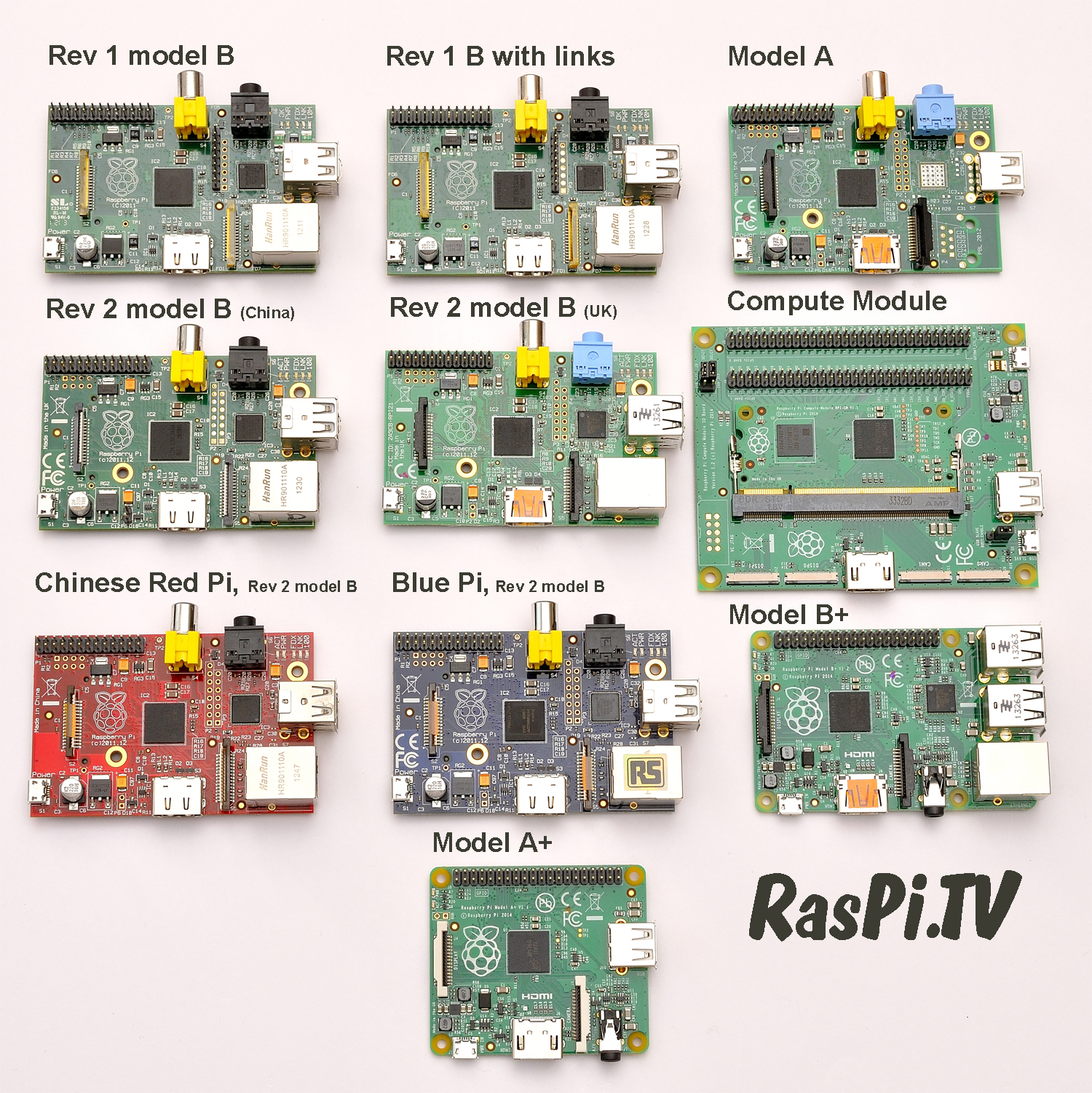Though the oldest records of the Raspberry Pi family claim that the arch version was round and actually tasted like raspberry, I'll confine myself to those models that were designed by the Raspberry Pi Foundation.
In the beginning that was but one Pi and it's model was..Model B. Not a bad beginning when you're constructed in the same country that gave us Terry Pratchett. Mind you: it was still 2012 back then.
Model B (aka 0002) later -2013- got a brother named Model A (aka 0008), which was cheaper and simpler by virtue of having no network capability, just one USB port and having no more than 256MB of RAM.
Introduced in June 2014 there was an illegitimate kind of offspring introduced that needed a Compute Module development board to be able to function, the so-called Compute Module(aka 000d), known for its hideous prices at the resellers, especially the combo of development board and compute module, charging hundreds of euro's for them. They can stick them where the sun doesn't shine! Actually a very painful experience, viewed by the GPIO pins...
In 2015 the youngest family member of the first generation (though some claim it was a child of Model A) saw the light: the Raspberry Pi Zero (aka 900092), that for the sake of cheapness had lost all that was not strictly needed for basic operation, including a large part of PCB surface.
That first generation has in common that they are all based upon the Broadcom BCM2835 SOC, featuring an ARMv6Z architecture ARM11 CPU and a VideoCore IV GPU. There are some minor variants/descendants worth mentioning of the first generation:
Variants:
Where there is profit there will be people or companies that will help themselves to a share of it, sometimes even without knowledge of the original manufacturer. In a klatch-as-klatchian-can the models 0003 and 0004 can be said to be minor variants of 0002, but China-made 000d -that came out in both red and blue instead of the familiar green- defies family resemblance. Revision 2.1 of the Model B (aka 00oe) was again UK-made, while 000f was again China-manufactured, but green this time.
Descendants:
Model B sprouted Model B+ (aka 0010) in July 2014. B+ gave us the basic form of the modern Raspberrie Pi's, including the four USB 2.0 ports. The model B+ was also manufactured in China, using a fitting red PCB and also reporting as 0010, just like the original.
Model A sprouted Model A+ (aka 0012) -we observe a pattern here- in November 2014. A+ suffered from dwarf-growth, albeit not in such a severe form as their youngest sibling(?) Pi Zero. It even managed in a later form (aka 0016) to get more memory, 512 MB.
Model Zero has, besides it very basic 1.2 version a 1.3 version (aka 900093, with MIPI interface), a W version (aka 9000C1, Wireless plus Bluetooth) and a sort of illegal WH version (same as previous but also with onbard GPIO headers).
November 2014 family picture of the first generation, taken before the advent of the Raspberry Pi Zero.
The 2nd generation was kicked off by the introduction in February 2015 of the Raspberry Pi Model 2B (aka a01041), a model that would have made Hamlet proud -if he had lived that long. The Model 2B was a jump foreward, as it used a BCM2836 SOC, featuring a Quad-core ARMv7-A architecture ARM Cortex-A7 CPU and.... a VideoCore IV GPU. RAM was increased to 1GB and the speed was increased from the original 700 to 900 MHz.
After the introduction in 2016 of the 3rd generation Model 2B was produced in a variant 2B 1.2 (aka a22042) which used a BCM2837 SOC, featuring a Quad-core ARMv8-A architecture ARM Cortex-A53 CPU and.... a VideoCore IV GPU. This quickly introduced hybrid 2/3 version may be the reason that there are no further descendants and/or subversion of the Model 2. The (un)availabiilty of the BCM2836 SOC may play another role here.
The 3rd generation first saw the light with the introduction in February 2016 of the Raspberry Pi Model 3B (aka a02082), a model that got much lamented for not being named Model 3.14. The Model 3B was another jump foreward, as it used a BCM2837 SOC, featuring a Quad-core ARMv8-A architecture ARM Cortex-A53 CPU and.... a VideoCore IV GPU. Speed was increased to 1200 MHz, and WiFi and Bluetooth were standard onboard features.
Model 3B has variants produced in Japan (aka a32082) and in Brazil (aka a02082), the later made with a blue-green PCB.
A descendant of Model 3B is the Raspberry Pi Model 3B+ (aka a020d3) that differs in a still higher clockspeed (1400 MHz), faster ethernet, two-band WiFi, later bluetooth version and a metal-covered SOC.
The third generation also features a new Compute Module development board with a choice of two Compute Modules: Compute Module 3 (aka a020a0, with 4GB eMMC) and a Compute Module 3 lite (with provision for a SD-card)











 Reply With Quote
Reply With Quote